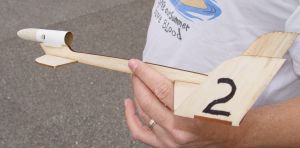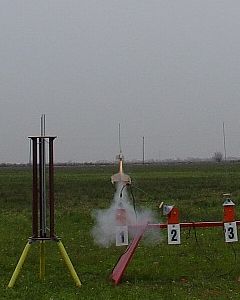| Construction Rating: | starstarstarstarstar |
| Flight Rating: | starstarstarstarstar |
| Overall Rating: | starstarstarstarstar |
| Manufacturer: | Edmonds Aerospace |
| Skill Level: | 1 |
| Style: | Glider |
 Brief:
Brief:
The Edmonds CiCi is a small, very easy to build boost glider that ejects the spent motor casing when the ejection charge goes off. The parts are laser cut and fit together perfectly.
Construction:
Here's the parts list:
- 8 laser-cut balsa pieces
- 1 balsa nose cone
- 1 motor tube
- 1 l/8" launch lug
That's it!
The instructions were illustrated and very easy to follow. The instructions consist of a single one-sided 8.5" x 11" sheet.
All of the glider parts are laser-cut balsa and they fit together perfectly. The parts are entirely cut out, with no trimming or separating from a balsa sheet needed. It would be possible to end up with some parts misaligned but taking care to make sure the pieces don't "droop" out of alignment until the glue is dry is simple enough. In fact, I pretty much just held them in place by hand for a few minutes and that was good enough to keep everything aligned until the glue was dry.
One possible "gotcha": When the nose cone is installed, it looks like it's partially blocking the vent hole in the side of the motor tube. To supposedly "fix" this, I carved quite a bit of balsa from around the nose cone shoulder in order to open up the vent hole. After I did this and glued the nose cone on, I contacted Rob Edmonds by email, who told me that the vent hole is supposed to be about halfway obstructed by the nose cone shoulder. Oh well. As it turns out, this doesn't seem to make any appreciable difference either way. My sons and I have built three CiCi's, have flown two of them, and the motor ejected just fine from both of them.
The motor tube is glued to the top of the front of the fuselage. It is possible to misalign so it's not pointing precisely straight ahead. The launch lug is glued onto the side of the fuselage and against the motor tube, so the lug is automatically aligned by those two parts.
I've managed to build CiCi's with the vent hole on the same side as the launch lug as well as on the opposite side but that doesn't seem to make any difference in flight. I'd probably recommend having the vent hole on the opposite side from the launch lug, but I don't recall what the instructions say to do.
I used Aleene's Original Tacky Glue (in the gold bottle) for all construction. It's similar to Elmer's white glue but is thicker and supposedly doesn't shrink when it dries.

Finishing:
I absolutely love the finishing of the CiCi. There is none! Flying them bare and without being airfoiled is recommended. That's right up my alley.
You can "finish" the CiCi by coloring it with a marker or highlighter if you like and for the sake of improved visibility.
Construction Rating: 5 out of 5
Flight:
My first CiCi flight was on an Estes A8-3. My main problem was not knowing how loosely the motor should fit in the motor tube in order to eject properly. I probably spent ten minutes, using very slightly larger and larger strips of masking tape on the motor, to get it just tight enough that it wouldn't fall out on the launch pad with the igniter clips hooked up.
Flight was perfectly straight up to maybe 100 feet, although I'm a poor judge of altitudes. The motor ejected perfectly, didn't hit anyone, and the glider performed a nice flat glide into the grass.
Second flight was on an Estes C6-5. Boost was good but the CiCi arched over considerably before the motor ejected. The glide was again very nice and the landing was in the grass.
 Third flight was on an Estes C6-3, as I thought the long delay of the C6-5 had caused the glider to arc over before ejecting the motor. On this flight too though, the glider arched over quite a bit before ejecting the motor and transitioned into a nice glide down into the grass once again.
Third flight was on an Estes C6-3, as I thought the long delay of the C6-5 had caused the glider to arc over before ejecting the motor. On this flight too though, the glider arched over quite a bit before ejecting the motor and transitioned into a nice glide down into the grass once again.
Recovery:
There was no damage whatsoever other than some grass stains on the leading edge of the wings. No burning or scorching, no cracked or broken fuselage, nothing.
The only possible CON would be the fact that the motor is ejected from the model and free falls to the ground. Every CiCi flight should probably be a head's up flight for this reason.
Flight Rating: 5 out of 5
Summary:
I really like the CiCi. These flights were trial runs for an upcoming Cub Scout event, the Pack 1283 Rocket Launch 2005 coming up this June. I've purchased enough CiCi kits for all of the Cub Scouts in my den to build one for himself. Rob Edmonds has a great pricing program for schools and scouts. Just go to his website to take a look.
Main PROs: Very simple to build, perfect alignment of laser-cut parts, cool flight profile.
Main CONs: Ejecting the motor to freely fall back to the ground at burnout. This doesn't particularly bother me, but I know some people object to "spitting" a rocket's motor without a streamer.
Overall Rating: 5 out of 5
Other Reviews
- Edmonds Aerospace CiCi By Dave Sutter
( Contributed - by Dave Sutter) The CiCi is a traditional canard-style boost glider. The canard is the name for that smaller front wing, or horizontal stabilizer. A canard-style glider is simply a glider where the canard is forward of the main wing. A boost glider is a glider that boosts straight up like a rocket, and then ejects some part, usually the engine, to change into a glider. ...
 |
 |
Flights
 |
 |
S.B. (January 1, 2001)
B.E. (May 1, 2001)
B.C. (May 1, 2001)
D.S. (January 17, 2003)
J.C.S. (August 31, 2003)
J.W.M. (September 2, 2003)
D.W. (August 22, 2004)
Sponsored Ads
 |
 |












D.F. (December 1, 1999)